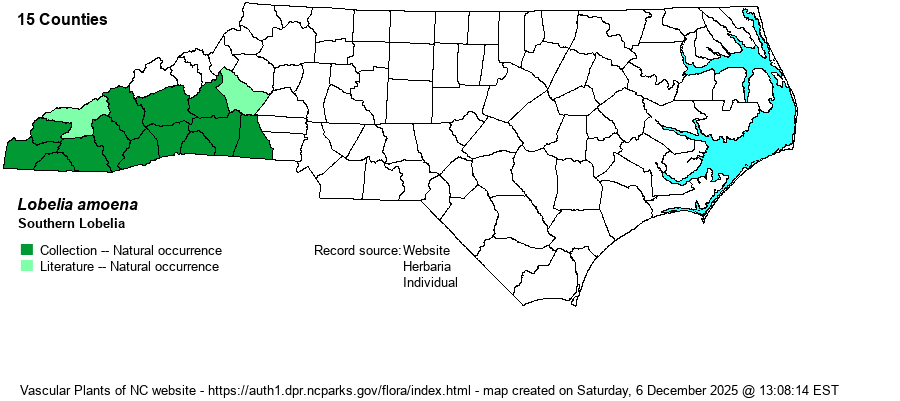| Author | Michaux | |
| Distribution | Present over the southwestern Piedmont and the southern Mountains, from Burke and Cleveland counties westward.
This is a Southeastern species, ranging from southwestern NC and then southwestward to central AL and the FL Panhandle. | |
| Abundance | Uncommon to frequent within its NC range. | |
| Habitat | This is a wetland species, growing along stream banks, in floodplain forests, in marshes, in seeps, and in other similar wet places (but not usually in bogs). | |
| Phenology | Blooms from late July to October, and fruits shortly after flowering. | |
| Identification | This is one of several wetland species of Lobelia that are quite similar, and thus you must take care in the identification. These species are fairly tall, growing as an erect herb to 2 feet tall, rarely to 3 feet tall, usually unbranched. They have numerous alternate stem leaves. In this species, each leaf is lanceolate to elliptical, about 4 inches long and about 1.5 inches wide, with serrated margins. The top 3-5 inches of the stem is a raceme of numerous (20 or more) flowers, each of which is violet-blue to medium blue. The flower is about 3/4-inch long, tubular and with two lips, the lower with three lobes and extending far beyond the two small upper lobes. In this species, the leaves are thin and flexible, as opposed to thick and stiff in L. elongata, which does not overlap in range but is a Coastal Plain species. However, L. georgiana can occur in the same area with L. amoena; that species can be separated by usually thick leaves "with a parchmentlike texture" (Weakley 2018); and some calyx segments usually with small teeth (as opposed to all calyx segments entire and thus no teeth). The common L. puberula has a densely pubescent stem, whereas L. amoena has a smooth stem. In summary, this is a thin-leaved species with entire sepals. | |
| Taxonomic Comments | Though considered as a good species by nearly all references, there is still some uncertainty about the identities of all specimens among the complex of L. amoena, L. elongata, L. georgiana, and L. glandulosa.
| |
| Other Common Name(s) | None | |
| State Rank | S3? [S3S4] | |
| Global Rank | G4? | |
| State Status | | |
| US Status | | |
| USACE-agcp | OBL link |
| USACE-emp | OBL link |

